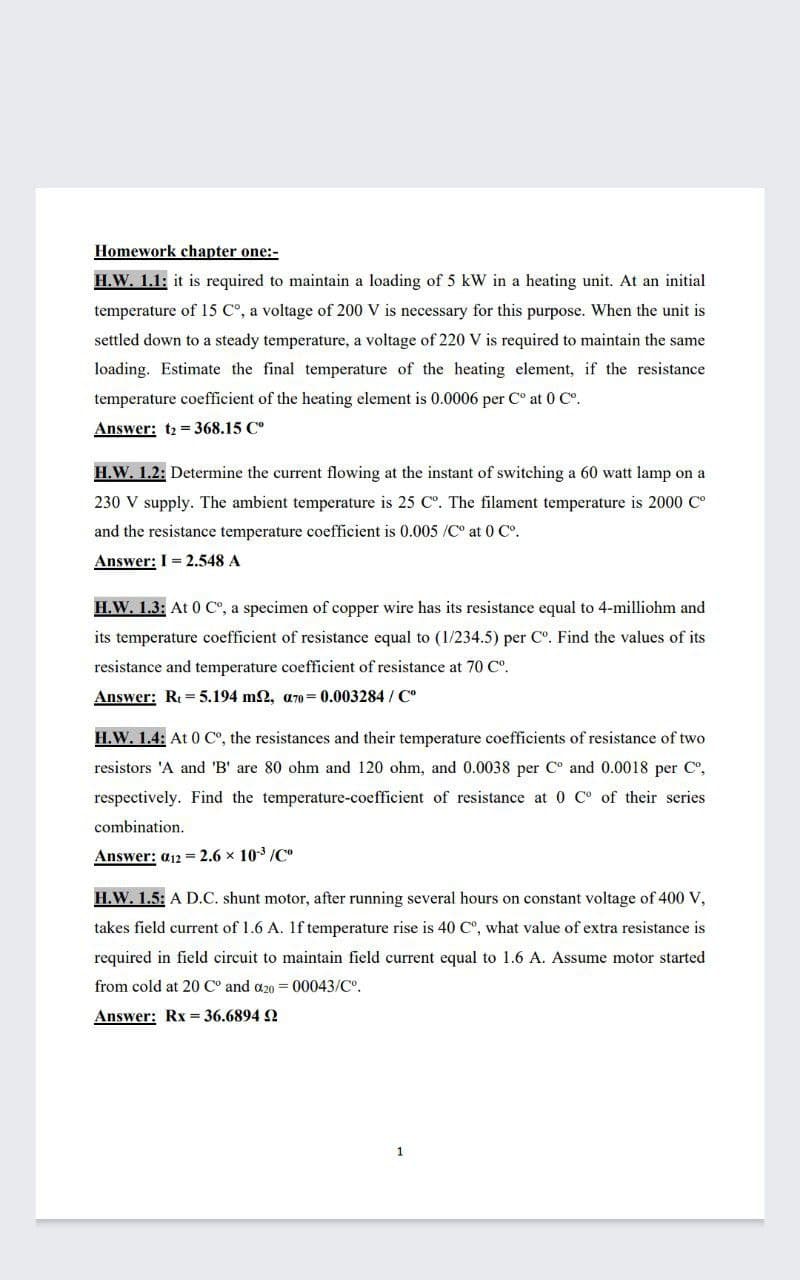H.W. 1.1: it is required to maintain a loading of 5 kW in a heating unit. At an initial temperature of 15 C°, a voltage of 200 V is necessary for this purpose. When the unit is settled down to a steady temperature, a voltage of 220 V is required to maintain the same loading. Estimate the final temperature of the heating element, if the resistance temperature coefficient of the heating element is 0.0006 per C° at 0 C°.
H.W. 1.1: it is required to maintain a loading of 5 kW in a heating unit. At an initial temperature of 15 C°, a voltage of 200 V is necessary for this purpose. When the unit is settled down to a steady temperature, a voltage of 220 V is required to maintain the same loading. Estimate the final temperature of the heating element, if the resistance temperature coefficient of the heating element is 0.0006 per C° at 0 C°.
Chapter9: Current And Resistance
Section: Chapter Questions
Problem 46P: An electronic device designed to operate at any temperature in the range from 10.0C to 55.0C...
Related questions
Question

Transcribed Image Text:Homework chapter one:-
H.W. 1.1: it is required to maintain a loading of 5 kW in a heating unit. At an initial
temperature of 15 C°, a voltage of 200 V is necessary for this purpose. When the unit is
settled down to a steady temperature, a voltage of 220 V is required to maintain the same
loading. Estimate the final temperature of the heating element, if the resistance
temperature coefficient of the heating element is 0.0006 per C° at 0 Co.
Answer: t2 = 368.15 C°
H.W. 1.2: Determine the current flowing at the instant of switching a 60 watt lamp on a
230 V supply. The ambient temperature is 25 C°. The filament temperature is 2000 C°
and the resistance temperature coefficient is 0.005 /C° at 0 C°.
Answer: I = 2.548 A
H.W. 1.3: At 0 C°, a specimen of copper wire has its resistance equal to 4-milliohm and
its temperature coefficient of resistance equal to (1/234.5) per Co. Find the values of its
resistance and temperature coefficient of resistance at 70 C°.
Answer: Re= 5.194 m2, a70= 0.003284 / C°
H.W. 1.4: At 0 C°, the resistances and their temperature coefficients of resistance of two
resistors 'A and 'B' are 80 ohm and 120 ohm, and 0.0038 per C° and 0.0018 per C,
respectively. Find the temperature-coefficient of resistance at 0 C° of their series
combination.
Answer: a12 = 2.6 x 103 /C"
H.W. 1.5: A D.C. shunt motor, after running several hours on constant voltage of 400 V,
takes field current of 1.6 A. 1f temperature rise is 40 C°, what value of extra resistance is
required in field circuit to maintain field current equal to 1.6 A. Assume motor started
from cold at 20 C° and a20 = 00043/Co.
Answer: Rx 36.6894 2
1
Expert Solution
This question has been solved!
Explore an expertly crafted, step-by-step solution for a thorough understanding of key concepts.
Step by step
Solved in 6 steps

Knowledge Booster
Learn more about
Need a deep-dive on the concept behind this application? Look no further. Learn more about this topic, physics and related others by exploring similar questions and additional content below.Recommended textbooks for you

